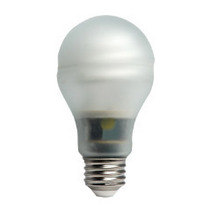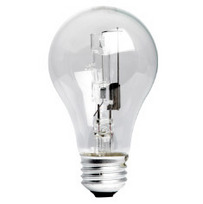|
Dear Living Green 365 readers,
These days there are so many light bulb choices that it can be confusing to choose the best bulb for your fixture. Here's a bit of information about bulb choices, plus some great resources to help you navigate this rapidly evolving aisle of the hardware store!
Lighting accounts for close to 20 percent of the average home's electric bill. Most of us can cut our lighting costs in a few simple steps. Start with conservation. It’s free and you can do it today.
- Always turn off the lights when you leave a room.
- Open curtains and shades to bring in daylight and reduce the need for electric lighting.
- Consider an occupancy sensor if you have lights that are frequently left on when no one is around.
The next step is to purchase energy-efficient bulbs for your fixtures. The three most common types of bulbs are light-emitting diode (LED), compact fluorescent (CFL), and energy-saving incandescent. Be sure any bulb you buy is ENERGY STAR qualified, which means it meets energy-efficient standards.
|
Light emitting diode (LEDs)
The
LED is one of today's most energy-efficient and rapidly developing
lighting technologies. ENERGY STAR-qualified LEDs use only 25%
of the energy, and last up to 25 times longer than the traditional
incandescent bulbs they replace. While LEDs are more expensive at this
early stage of development, they still save money because they last a long time and use very little energy.
LED bulbs are currently
available in many products such as replacements for 40W, 60W, and 75W
traditional incandescents, reflector bulbs often used in recessed
fixtures, and small track lights.
LED bulbs are available in a range of colors, including warm white.
|
|
 |
|
Compact fluorescent (CFLs)
CFLs
are simply curly versions of the long tube fluorescent lights you may
already have in a kitchen or garage. An ENERGY STAR-qualified CFL uses
about one-fourth the energy and lasts 10 times longer than a comparable
incandescent bulb. CFL bulbs are available in a range of light colors, including warm tones, and work best in a fixture that is used for at least 15 minutes at a time.
Dimmable
CFLs are available, but dim differently than incandescent bulbs.
Incandescents dim smoothly from 100% of their light output to no output
and their light color changes from a bright white to a warmer yellow.
Dimmable CFLs maintain light color more consistently and dim to 10–40%
of the original brightness. CFL dimmer switches are available that take this difference into account and can improve the performance of your dimmable CFL.
|
|
 |
A spiral CFL won’t last as long in
a fixture with low air-flow, such as recessed lighting. For these types
of fixtures, use a CFL specially designed for recessed lighting or an
LED bulb.
Covered CFLs, such as globe bulbs or recessed
reflector bulbs, need a little time to “warm up” and reach full
brightness, so they are less suited to a light that is turned off and on
frequently.
|
Energy-saving incandescent
Energy-saving,
or halogen, incandescents have a capsule inside that holds gas around a
filament to increase bulb efficiency. This type of incandescent bulb is
about 25% more efficient and can last up to three times longer than
traditional incandescent bulbs.
Energy saving incandescents are available in a wide range of shapes and colors, and can be used with dimmers.
“Lighting facts” help you choose bulbs
Light
bulb packages now include “lighting facts,” similar to a nutrition
facts label on food. Standardized information is listed, including:
|
|
 |
- Brightness (lumens)
- Estimated annual energy cost
- Bulb life expectancy (years)
- Light appearance (cool or warm)
- Energy used (watts)
- If the bulb contains mercury
If you are replacing an incandescent bulb and you know
how many watts that bulb used, you can buy a comparable bulb by looking
for the proper lumens, or brightness:
- Replace a 60W bulb with a bulb that gives you 800 lumens.
- Replace a 40W bulb with a bulb that gives you 450 lumens.
|
|
 |
The new light bulb law
The Energy Independence and Security Act of 2007 (EISA) includes new energy-efficiency standards for light bulbs
that began to take effect on January 1, 2012. The purpose of the law is
to make light bulbs 25-80% more efficient than standard incandescent
bulbs. Many manufacturers are developing more energy-efficient
incandescent bulbs to meet the standards. A growing number of CFL and LED are also available.
Where can I recycle my CFLs?
When CFLs burn out, state law requires
recycling. CFLs contain a small amount of mercury, which is harmful to
the environment if put in the garbage. Many local hardware stores
collect used CFLs, as well as Lowes, Home Depot, Menards, and IKEA. For a
list of retailers that accept used CFLs, go to www.earth911.org or the EPA web site. Your county household hazardous waste program may also collect them. Find your county’s HHW program at www.pca.state.mn.us/hhw.
Additional resources
Living in the Avon Hills is a conference about arts, land use, natural history, wildlife, and alternative energy. This family-friendly event is put on by the Avon Hills Initiative and St. John’s Arboretum, February 25, St. John’s University (Collegeville).
The Twin Cities Sustainable Communities Conference, organized by the Alliance for Sustainability, will link volunteer leaders from neighborhoods, gardens, congregations, and schools with project resources, March 24, 8:30 a.m.-3:30 p.m., U of M McNamara Center (Minneapolis).
Solar Works in Central MN: Workshop & Resource Fair is a Clean Energy Resource Teams event that will connect you with solar experts serving central Minnesota. You'll learn about your site, specific technologies, financing options, and your solar resource, March 28, 1-4 p.m., Riverside Park (Saint Cloud).
The 8th Annual Community Garden Spring Resource Fair is organized by Gardening Matters, a Twin Cities based non-profit dedicated to successful and sustainable community gardens in Minnesota. The Resource Fair is one of the key venues in which people are able to come together to share, imagine, and create stronger communities through gardening, March 31, 9 a.m.-4:30 p.m., Neighborhood House (St. Paul).
Living Green 365 is a newsletter of the Minnesota Pollution Control Agency. If you have questions or comments for Living Green 365 pleas send them to the address
below.
Sincerely,
Britt Gangeness and the Living Green Team
|